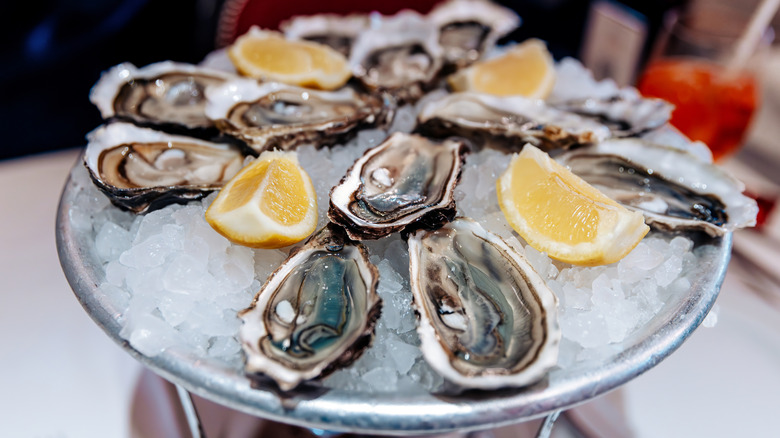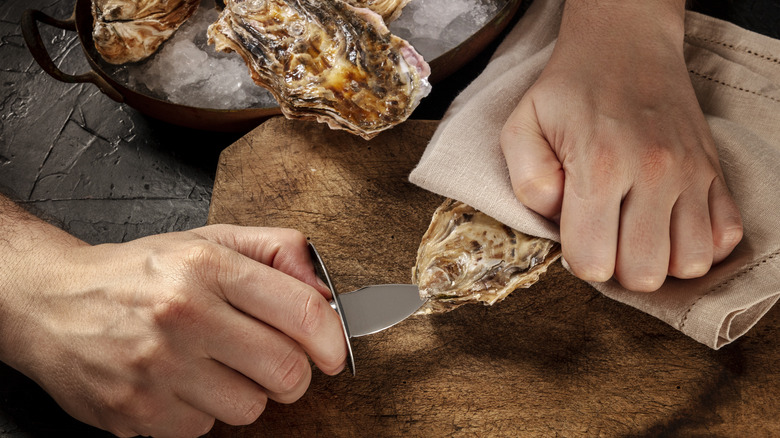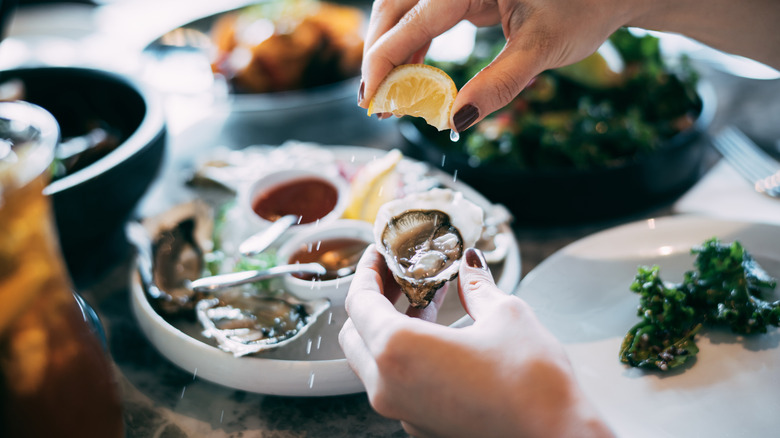How To Correctly Shuck And Eat Oysters Like A Pro
That old saying about only eating oysters in months that contain the letter "R"? Not totally accurate anymore. Thanks to modern refrigeration and sustainable harvesting, it's now possible to safely eat them all year round (to a degree, anyway — there's always some risk involved with eating raw oysters). Still, the cooler months are when they're at their peak, which means these months are a great time to incorporate them into your dinner party routine.
Just like filleting a fish or chiffonading some herbs, shucking an oyster is a knife skill you can use to impress your guests — not that you're doing this for the glory, of course. You're doing it because there's little as satisfying as a briny bivalve, served on the half shell with a bit of mignonette, and perhaps an ice-cold martini (or a flute of Champagne, which pairs wonderfully with oysters) to wash it down.
Shucking oysters will take practice, so don't worry if your first few attempts yield a bit of chipped shell or spilled oyster liquor. All you really need to shuck oysters well is an oyster knife and a kitchen towel. Feel free to also wear a protective glove, but part of the towel's point is to prevent you from inadvertently poking yourself. The oyster knife, by the way, is an important element — don't feel tempted to use a regular paring knife (or, heaven forbid, a butter knife), which could damage the oyster, the knife, your skin, your pride, or all of the above. Tools in place? Let's get down to business.
The safest way to shuck an oyster
To begin, fold your towel and place it on a flat surface. Place an oyster on the bottom fold of the towel with the cupped side down, the flat side facing up, and the hinge — i.e., the part you're trying to open — facing your dominant hand, which should be holding the oyster knife. With your non-dominant hand, fold the towel around the top of the oyster and hold it there to stabilize it, making sure you keep a bit of towel between your hand and the knife.
Work the tip of the blade gently into the oyster's hinge. You don't want to apply too much pressure here; just ease the blade in, twisting lightly back and forth as if jiggling a key in a lock. As you feel yourself severing the hinge, keep twisting — eventually, you'll register that satisfying "pop" that indicates the shell has come loose. Every time you pull the knife out of the oyster, wipe it on the towel to remove any grime or pieces of shell.
Now, run the blade all the way through the flat side of the shell to sever the muscle that attaches it to the oyster. Remove that piece of shell. Now, run the blade along the inside bottom of the cupped part, fully loosening the meat. Just make sure not to spill any of those delicious, briny juices while you do. Want to skip the whole knife-and-towel routine? No problem — we've got some shortcuts to share.
Oyster-shucking shortcuts — and how to eat them
Easier ways to open an oyster all involve manipulating temperature so it does the hard work for you. For instance: Put the oysters in the freezer for about six hours, then transfer them to the fridge, flat side up so they don't spill any juices. To stabilize them, arrange them on a bed of salt or on a wire rack set on a sheet pan. Within an hour, as they thaw, they should pop open. Then, you just have to sever the muscle that attaches them to their shells.
You can also use the oven to do basically the same thing. Place the oysters flat side up on a stable surface (like a wire rack or bed of salt) and put them under a broiler set to high. Check them after five minutes, removing any oysters whose shells have popped open. Continue checking periodically for five minutes more, removing oysters as you go. Once you hit the 10-minute mark, discard any that haven't opened, as this might indicate spoilage. Oysters opened with this method won't be fully raw, but they won't be fully cooked, either — they'll be warm but still incredibly juicy.
How you eat them is all about personal preference. For example, you can grill the oysters for a little decadence at home. Many folks love them raw, though, with just a few select condiments. Whip up a mignonette or twist open a bottle of cocktail sauce. Unwrap a sleeve of saltines. Slice up some lemons and dribble on some hot sauce. The world is your ... well, you know.


